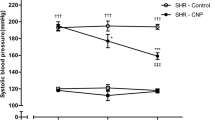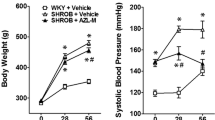Summary
This study was designed to investigate the effects of candesartan on blood pressure (BP) and blood pressure variability (BPV) reductions, baroreflex sensitivity (BRS) amelioration, and organ protection in spontaneously hypertensive rats (SHR). Methods: Studies were performed in two groups of SHR (n = 13 for control rats; and n = 20 for candesartan-treated rats) and one group of WKY rats (n = 13). Candesartan (3mg /kg/d) was given in rat chow for 4 months. BP was then continuously recorded for 24 hours in conscious state. After the determination of BRS, rats were killed for organ-damage evaluation. Results: Long-term treatment with candesartan significantly reduced BP and BPV expressed by both standard deviation and variation coefficient of BP, enhanced BRS and produced obvious organ protection. Compared with BP level, BPV and BRS values showed a closer or similar relationship with organ-damage parameters in SHR. Multiple regression analysis showed that the decrease in left ventricular hypertrophy was most closely associated with the increase in BRS, whereas the decrease in aortic hypertrophy was most closely associated with the decrease in 24-hour systolic BPV, and the amelioration in renal lesions, with the increase in BRS and the decrease in 24-hour systolic BPV. Conclusion: long-term treatment with candesartan results in organ protection in SHR. Besides BP reduction, the decrease in BPV and the restoration of BRS are significantly related to this organ protection.
Similar content being viewed by others
References
Taal MW, Brenner BM. Renoprotective benefits of RAS inhibition: from ACEI to angiotensin II antagonists. Kidney Int 2000;57:1803–1817.
Dahlof B, Devereux RB, Kjeldsen SE, Julius S, Beevers G, Faire U, Fyhrquist F, Ibsen H, Kristiansson K, Lederballe-Pedersen O, Lindholm LH, Nieminen MS, Omvik P, Oparil S, Wedel H. The LIFE Study Group. Cardiovascular morbidity and mortality in the Losartan Intervention for endpoint reduction in hypertension study (LIFE): a randomised trial against atenolol. Lancet 2002;359:995–1003.
Berl T. Angiotensin-converting enzyme inhibitors versus AT1 receptor antagonist in cardiovascular and renal protection: the case for AT1 receptor antagonist. J Am Soc Nephrol 2004;15 Suppl 1:S71–76.
European Society of Hypertension-European Society of Cardiology Guidelines Committee. 2003 European Society of Hypertension-European Society of Cardiology guidelines for the management of arterial hypertension. J Hypertens 2003;21:1011–1053.
Parati G, Pomidossi G, Albini F, Malaspina D, Mancia G. Relationship of 24-hour blood pressure mean and variability to severity of target organ damage in hypertension. J Hypertens 1987;5:93–98.
Su DF, Miao CY. Reduction of blood pressure variability: a new strategy for the treatment of hypertension. Trends Pharmacol Sci 2005;26:388–390.
Parati G, Mancia G. Blood pressure variability as a risk factor. Blood Press Monit 2001;6:341–347.
Su DF, Miao CY. Blood pressure variability and organ damage. Clin Exp Pharmacol Physiol 2001;28:709–715.
Su DF, Miao CY. Functional studies of arterial baroreflex function in conscious rats. Acta Pharmacol Sin 2002;23:673–639.
Sleight P. The importance of autonomic nervous system in health and disease. Aust N Z J Med 1997;27:467–473.
McConnaughey MM, McConnaughey JS, Ingenito AJ. Practical consideration of the pharmacology of angiotensin receptor blockers. J Clin Pharmacol 1999;39:547–559.
Xie HH, Miao CY, Liu JG, Su DF. Effects of long-term treatment with candesartan on organ damages in sinoaortic denervated rats. J Cardiovasc Pharmacol 2003;41:325–331.
Norman RA Jr, Coleman TG, Dent AC. Continuous monitoring of arterial pressure indicates sinoaortic denervated rats are not hypertensive. Hypertension 1981;3:119–125.
Smyth HS, Sleight P, Pickering GW. Reflex regulation of arterial pressure during sleep in man: a quantitative method of assessing baroreflex sensitivity. Cir Res 1969;24:109–121.
Fu YJ, Shu H, Miao CY, Wang MW, Su DF. Restoration of baroreflex function by ketanserin is not blood pressure dependent in conscious freely moving rats. J Hypertens 2004;22:1165–1172.
Xie HH, Miao CY, Jiang YY, Su DF. Synergism of atenolol and nitrendipine on hemodynamic amelioration and organ protection in hypertensive rats. J Hypertens 2005;23:193–201.
Lu ZA, Xie HH, Xu LP, Yin AF, Miao CY, Su DF. Restoration of arterial baroreflex function contributes to organ protection in spontaneously hypertensive rats treated with long-term hydrochlorothiazide mixture. Clin Exp Pharmacol Physiol 2003;30:49–54.
Hayakawa H, Raij L. The link among nitric oxide synthase activity, endothelial function, and aortic and ventricular hypertrophy in hypertension. Hypertension 1997;29:235–241.
Xie HH, Shen FM, Cao YB, Li HL, Su DF. Effects of low-dose ketanserin on blood pressure variability, baroreflex sensitivity and end-organ damage in spontaneously hypertensive rats. Clin Sci (Lond) 2005;108:547–552.
Miao CY, Tao X, Gong K, Zhang SH, Chu ZX, Su DF. Aterial remodeling in chronic sinoaortic- denervated rats. J Cardiovasc Pharmacol 2001;37:6–15.
Kimula K, Tojo A, Matsuoka H, Sugimoto T. Renel arteriolar diameters in spontaneously hypertensive rats: Vascular cast study. Hypertension 1991;18:101–110.
Kikuya M, Hozawa A, Ohokubo T, et al. Prognostic significance of blood pressure and heart rate variabilities: the Ohasama study. Hypertension 2000;36:901–906.
Mancia G, Omboni S, Parati G. The importance of blood pressure variability in hypertension. Blood Press Monit 2000;5 Suppl 1:S9–15.
Sander D, Kukla C, Klingelhofer J, Winbeck K, Conrad B. Relationship between circadian blood pressure patterns and progression of early carotid atherosclerosis: A 3-year follow-up study. Circulation 2000;102:1536–1541.
Liu JG, Xu LP, Chu ZX, Miao CY, Su DF. Contribution of blood pressure variability to the effect of nitrendipine on end-organ damage in spontaneously hypertensive rats. J Hypertens 2003;21:1961–1967.
McClellan KJ, Goa KL. Candesartan cilexetil: a review of its use in essential hypertension. Drugs 1998;56:847–869.
Parmer RJ, Cervenka JH, Stone RA. Baroreflex sensitivity and heredity in essential hypertension. Circulation 1992;85:497–503.
Parmer RJ, Cervenka JH, Stone RA, O'Connor DT. Autonomic function in hypertension: are there racial difference? Circulation 1990;81:1305–1311.
Brown AM. Receptors under pressure: an update on baroreceptors. Circ Res 1980;46:1–10.
Matsumura K, Averill DB, Ferrario CM. Angiotensin II acts at AT1 receptors in the nucleus of the solitary tract to attenuate the baroreceptor reflex. Am J Physiol 1998;275:R1611–1619.
Bristow JD, Honour AJ, Pickering GW, Sleight P, Smyth HS. Diminished baroreflex sensitivity in high blood pressure. Circulation 1969;39:48–54.
Shan ZZ, Dai SM, Su DF. Relationship between baroreceptor reflex function and end-organ damage in spontaneously hypertensive rats. Am J Physiol 1999;277:H1200–1206.
Author information
Authors and Affiliations
Corresponding author
Rights and permissions
About this article
Cite this article
Xie, HH., Chen, YY., Miao, CY. et al. Effects of Long-Term Treatment with Candesartan on Hemodynamics and Organ Damage in Spontaneously Hypertensive Rats. Cardiovasc Drugs Ther 19, 391–397 (2005). https://doi.org/10.1007/s10557-005-5734-8
Published:
Issue Date:
DOI: https://doi.org/10.1007/s10557-005-5734-8




